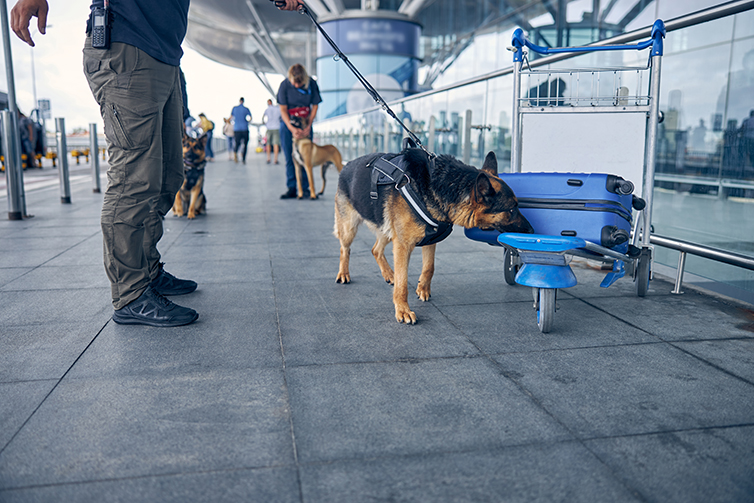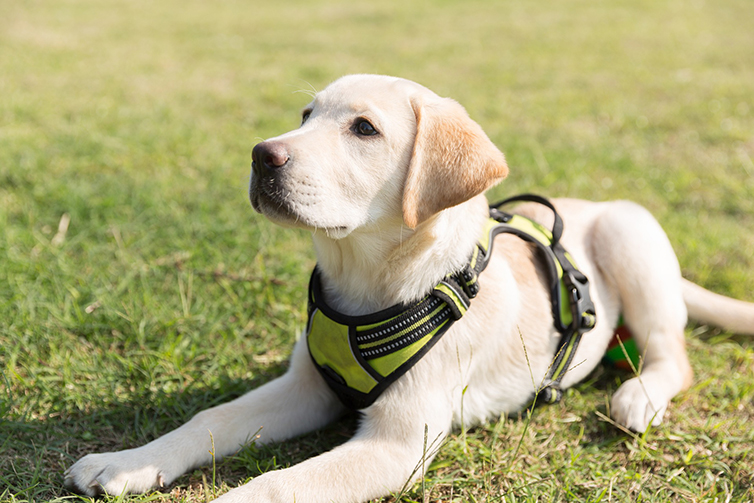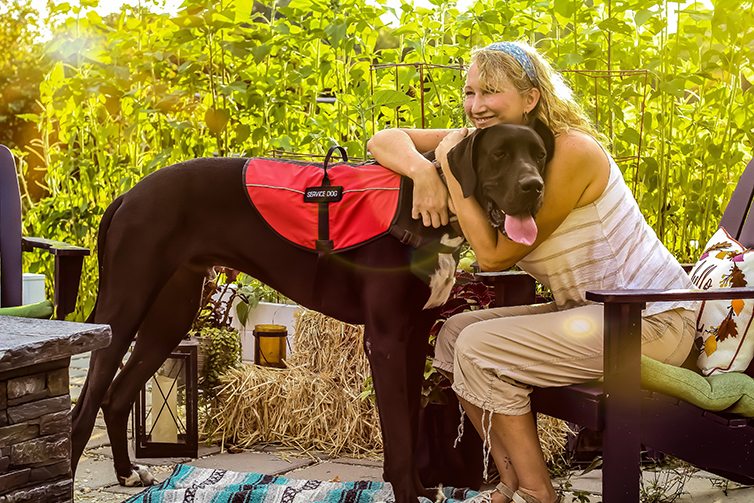Can We Be Of Service?!
Who discovered that dogs could work?
Dogs were the first animals domesticated by humans, more than 30,000 years ago, according to archeological evidence. It is believed that wolves, our dogs’ ancestors, began to move closer to humans and began to scavenge bits of food from hunter-gatherer Neanderthal humans, who began to domesticate these wild animals, giving them food and shelter. These humans were mainly cave dwellers, in Europe and parts of Asia.

Using our imaginations, we can construct a likely scenario for what happened on that first encounter. Perhaps a group of hunters killed a she-wolf (Sorry, but it must have happened.) and discovered a cub, which one of the men took back to his cave, to the delight of his children? The wolf grew to become domesticated and the children named him Ug-Ug (They didn’t have great imaginations back then.).
The children would throw bits of meat to the dog, and one evening, the animal brought a piece of meat back to them. The children were beside themselves with joy and threw some more, while shouting the Neanderthal equivalent of ‘Fetch’ and rewarding the Ug-Ug every time he did this. Some time later, Dad, wondering if this could be put to good use (He was an extremely intelligent Neanderthal.) took Ug-Ug hunting with him and the rest, as they say, is history… The wolf had become a working dog.
What’s the Difference Between Service and Working Dogs?
There seems to be much disagreement over this question. For the purposes of this blog, we shall categorise all dogs who are task-trained to assist people with disabilities, both physical and mental, as ‘service’ dogs: eg guide dogs, hearing dogs, diabetic alert dogs, seizure alert dogs, wheelchair assistance dogs, autism assistance dogs, and therapy dogs, who mainly act as companions to people with psychiatric illnesses.
‘Working’ dogs, are trained to assist people in performing certain tasks. For example, police dogs, military dogs, anti-poaching dogs, sniffer dogs, hunting and herding dogs and rescue dogs.
In this blog, we’re going to look first at service dogs. You’ll be surprised at the number and type of services they perform. Next month, we’ll focus on working dogs.
But first, a question which may be worrying some of you:
Is it Cruel to Make a Dog Work?
Surely little Munchkins or big Steamroller are very happy lying on the couch, being fed and petted all day long? (Sounds like many of us during Covid lockdown.) What a wonderful life! Most of us who feel very strongly about the physical and psychological well-being of dogs, and who know how intelligent these wonderful animals can be, may have wondered about their level of boredom. Is it always enough to throw the ball and take your dogs for a walk each day? What about the hours and hours they may spend alone? For an intelligent being? Most of us work or go out, leaving our dogs alone and bored for the best part of each day.
Now, we’re not talking about teaching Steamroller to read or enrolling him in a college course here. But we all know the effects of prolonged boredom, which can in fact lead to depression. This also, you may be surprised to learn, can apply to dogs. They’re obviously not as intelligent as us, (although my little Yorkie…). But seriously, we require much more mental stimulation than they do.
But smart and capable animals like dogs, do get bored and may also become depressed. Their ancestors would spend each day running, chasing and hunting. Is Steamroller happy and fulfilled by lying on the couch or the chaise lounge all day, with mommy bringing him his meals and even giving him treats like the remainder of Sunday’s trifle? Weeell … to some extent, he may think he is. But many animal experts will agree that dogs, like humans, need something worthwhile to DO, as long – and this is a very important caveat – as they are treated kindly and are happy doing their jobs. If the work is too demanding, if the dog is ill-treated, just as the boredom of doing nothing all day is detrimental to the dog’s physical and mental health, then dogs can become stressed and suffer from depression.
Working for their food, instead of just chomping their ‘free’ dinners, is what most dogs want, according to much scientific research. Researchers even have a name for it: they call it ‘contrafreeloading’. Yes, really. It happens in many species, except for … yep, cats. They have got free-loading off to a fine art, and they seem to love it. Mind you, they have the ability to jump walls and catch and eat small rodents, which of course keeps them pretty well occupied.
The biscuit treat is delicious, but the ‘feeling of achievement’ in having worked for that treat, even if the biscuit is a reward for fetching a ball, is satisfying, and it creates a very special bond between humans and dogs. We all need to have some sense of control over our surroundings, even if this just means retrieving a stick, and the owner says, “Good job, my boy.”
Working at a certain job does not, of course, suit every dog. Little Munchkins will never, with the best will in the world, make an effective guide dog. Some dogs are not suitable for working, physically or mentally. If a particular dog likes to be challenged and is able, whether by herding sheep or pressing an alert button for someone who has had a seizure, then perhaps it is worth letting them be challenged. But, say the experts, if they don’t, then don’t.
So, what kinds of service do these service dogs provide?

Imagine for a moment what it would be like for you if you lived alone and were unable, because of a mental or physical disability, to look after yourself; to go shopping; to visit friends; to contact anyone; to get your medicine from a shelf; to respond to an emergency; to switch the television on; to dress yourself; to cook… the list is very long. Until we actually meet or know someone with a disability, we are very often unaware of the problems encountered by these people. How on earth do they cope? Well … enter Super-Dog! The more fortunate of these disabled people often qualify for a trained dog to assist them and provide much-needed companionship.
These dogs, as previously mentioned, have been extensively trained to do the very important job of helping people with various types of physical and psychological disabilities. They are taught to perform specific tasks and to be a well-behaved helper in all situations. They are usually both a working dog and, in some cases, a lifelong companion. Studies have shown that they provide health benefits and can increase fitness, lower stress and increase feelings of happiness in their owners. Most of these dogs are selected as puppies and then trained.
In South Africa, there are various accredited organisations which train service dogs to perform tasks which are related to the person’s disability. Service dogs often accompany their person on trains, planes, boats, public transport and in restaurants, to hospitals, and other public places which often have strange noises and many people. Most of these dogs wear a Service Dog jacket with a harness or leash, when out in public, for quick identification.
Guide Dogs

Visually-impaired or blind people mainly need help in negotiating and avoiding obstacles. Guide dogs effectively use their eyes to replace the owner’s. Contrary to popular belief, guide dogs cannot navigate; the owner is trained to do the general navigation by steering the dog in the right direction. Another belief is that guide dogs can tell the difference between the red and green of robots. They can’t. They’re colour-blind for red and green. They can’t ‘read’ traffic lights or signs. They are taught, believe it or not, ‘intelligent disobedience’. This means they learn not to obey when the owner directs them to an unsafe situation or an obstacle.
They give their person more confidence, more mobility, a sense of security about going out-and-about, and, perhaps most important of all, companionship and friendship, creating a mutually-beneficial relationship. They allow their owners to take more exercise, to become more sociable and independent. A special bond develops between dog and owner
Guide dogs are protected by law in many countries and are allowed to accompany their owners into many public buildings. They may go into most restaurants with their owner and usually behave themselves a lot better than most children!
Sponsoring a guide dog puppy (or ‘recruit’! How cute is that?), either by a donation or by fostering a puppy for 24 months, is a most satisfying, rewarding and worthwhile thing to do.

(Website for the South African Guide Dogs Association for the Blind – a non-profit organisation: http://www.guidedog.org.za)
Mobility Service Dogs

These dogs help physically-disabled people and include those who are wheelchair dependent or have serious balance issues, often resulting from illness. They can fetch and carry objects, open and close doors, operate switches and, not least, provide a sense of security and companionship. They often wear a special harness which attaches to a cane-like handle, allowing the dog to guide and assist with balance.
Special ‘walker’ dogs are trained to assist people with illnesses such as Parkinson’s disease, multiple sclerosis and diabetes, when the person needs help with walking and balancing.
Hearing Dogs

A hearing dog has been specially selected and trained to assist deaf or hearing-impaired people, by alerting them to important sounds such as doorbells, smoke alarms, telephones (Deaf people can, of course, send and receive text messages.), alarm clocks, sirens, a car’s hooter, someone calling them etc. They are trained, upon hearing a noise, to make physical contact with their person and lead them towards, or in some cases, away from, the source of the noise.
Hearing dogs are also very important for when the person is out in public, increasing their awareness of their environment. These dogs are trained to physically alert their person and lead them away from a sound which may indicate danger, eg a fire alarm.
Medical Assistance Dogs

These dogs are trained to respond and act when their person has a seizure of some kind or becomes unconscious. They carry out custom-trained tasks, depending on the person’s illness and/or condition.
They are often able to:
- get help from another person or press an alert button
- bark to get attention
- give special deep pressure therapy during the seizure
- lick the person’s fingers and toes to try to stimulate and protect their person from harm
- give comfort and assistance after a seizure
These little ‘angels of mercy’ can also carry vital medication when out with their person, including emergency care information. Post-seizure, the dog can retrieve a phone or medication and help their person to stand and provide more deep pressure therapy. Many of these dogs, after bonding with their person for some time, can actually predict an oncoming seizure, allowing the person to get help or take medication.
Diabetic Alert Dogs: also known as DAD!
A diabetic person has to constantly monitor their glucose levels (which have to be regulated by the person instead of relying on their body to do this) to prevent going into a diabetic coma. A DAD is trained to use his/her incredible canine sense of smell to detect low glucose levels 30 minutes BEFORE a blood glucose monitor! This gives the person time to check and correct their insulin level before symptoms occur which may lead to a diabetic coma.
Studies in the UK have shown that, apart from the obvious psychological benefits of a DAD, owners experienced significantly less hypoglycaemic episodes, fewer paramedic call-outs, improved independence and overall improved quality-of-life. Unbelievable! Thanks, DADs.
Autism Support Dogs

Autism Spectrum Disorder is a developmental disability that causes social, behavioural and communication problems. Autism is not always obvious in the individual, but it affects how a person interacts with others. The learning capabilities of someone with autism can range from seriously challenged to gifted.
Signs of ASD begin in early childhood and usually last for the person’s lifetime. People with ASD have trouble relating to others and their feelings. Autism Support Dogs can often be a lifeline for the affected child and their family. The dog is controlled by a primary handler, usually one of the child’s parents, and a special harness with a lead, held by the child, is worn by the dog.
These dogs help the child by:
- being a companion – autistic children are often lonely and have problems mixing with their peers; an ASD support dog is often a novelty and may be the link to making friends;
- improving the child’s confidence, leading to more independence;
- assisting with speech therapy and lessons;
- provide physical closeness when the child is suffering from anxiety;
To the ASD child, the dog can help to make an often scary world, kinder..
Psychiatric Service Dogs
These dogs are trained to assist people with psychiatric problems, including those with severe depression, anxiety, panic attacks, post-traumatic stress disorder, obsessive compulsive disorder, dementia and paranoia. The dogs provide companionship for often very lonely people who often have no hope. These illnesses are usually invisible and much suffering takes place inside the brains of those with these disorders. The dogs also facilitate exercise, which increases certain hormones which can calm the person and give them structure to their day. Depressed and seriously anxious people often find their symptoms eased by a regular daily walk with their companion.
They can also remind their handler to take medication and provide deep pressure therapy. The dog can wake their person, encouraging him/her to get out of bed and start their day. The dog can also act as a physical barrier in public, which increases the confidence of the handler. Some people with psychiatric problems engage in repetitive or harmful behaviour – the dog can interrupt this, reminding them to stop. Other sufferers may have terrible, irrational fears (paranoia), which the dog is able to calm down.
And finally …
Dog owners, like most of us, are perfectly aware that dogs are wonderful, but those dogs whose job it is to make the world a nicer and kinder place for people with physical or psychological problems, are truly awesome.
References:
psychologytoday.com “Working for Food…”
https://andreaarden.com “What is a working dog?”
https://www.thesprucepets.com “7 types of working dogs”
info@medicalalertdogs.co.za “Honey’s Garden”
https://clovernook.org “Different types of working dogs”
https://breedingbusiness.com “Working dogs and service dogs”
Subscribe to our Newsletter
Get to know your furry friend better! Sign up for all things dog- or cat-related.
The Hairy Facts about the dreaded hairball
12 April 2021
Help! My dog’s barking mad! Volume 2
12 April 2021
Your Itchy, Scratchy Cat – All About Cat Skin Problems
12 April 2021
The Dog’s Diet: A Bone of contention?
01 April 2021
Mango Fly Worms: How to Spot and Eliminate them
Posted on November 28,2019
Managing Mange And Mites In Your Dog
Posted on June 11,2018
Why Do Cats Purr and How? Learn What Your Cat Is Saying
Posted on October 14,2020
How to Get Rid of Ear Mites in Dogs
Posted on November 06,2019









